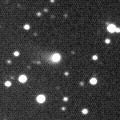
|
It was faint as 16.4 mag at the discovery in March (Mar. 12, R. H. McNaught). Then it brightened well as expected, and became visible visually as 12.2 mag in August (Aug. 3, Juan Jose Gonzalez). Now it is 10.4 mag (Dec. 22, Juan Jose Gonzalez). It was very small and sharp before, however, now the size exceeds 2 arcmin and it looks like a typical small comet. It will reach to 10 mag from January to March. In the Southern Hemisphere, it is observable only until December. In the Northern Hemisphere, the altitude will be getting lower slowly after January, and it will be too low to observe in April.
Date(TT) R.A. (2000) Decl. Delta r Elong. m1 Best Time(A, h)
Dec. 24 21 34.12 -14 52.1 2.222 1.740 48 10.5 21:02 ( 81, 13)
Dec. 31 21 49.96 -12 33.7 2.223 1.696 46 10.4 21:03 ( 81, 9)
|

|
It was expected to reach to 9 mag in 2006 spring. But actually, it is much fainer than expected, 13.9 mag on Aug. 1 and 11.7 mag still on Oct. 27 (Michael Mattiazzo). It seems to be a comet with very slow brightness evolution, similar to C/2003 T4. It will be 11 mag at best. It is not observable until late March in the Northern Hemisphere, but will be observable for a long time while it is getting fainter after that. It will be too low even in the Southern Hemisphere from January to February. It was reported as 13.3 mag on Dec. 9 (Andrew Pearce). So maybe it is fading unexpectedly?
Date(TT) R.A. (2000) Decl. Delta r Elong. m1 Best Time(A, h)
Dec. 24 20 14.06 -57 21.2 2.341 1.719 40 11.5 21:02 ( 34, 22)
Dec. 31 20 16.39 -53 57.3 2.385 1.687 35 11.5 21:03 ( 35, 16)
|

|
It had been so faint as around 15 mag for a long time since May. It had been too faint to see visually. However, an outburst occured on Sept. 9 and it brightened to 13 mag (Stephane Garro). Another outburst occured on Nov. 2, and it reached to 12.5 mag (Piotr Guzik). After that, it keeps somewhat faint around 14-15 mag.
Date(TT) R.A. (2000) Decl. Delta r Elong. m1 Best Time(A, h)
Dec. 24 1 43.30 21 48.6 5.235 5.778 119 13.3 21:02 (156, 29)
Dec. 31 1 43.48 21 37.0 5.337 5.779 112 13.4 21:03 (149, 27)
|

|
It brightened faster than a typical comet, and became visible visually as 13.5 mag in October (Oct. 24, Seiichi Yoshida). Now it is 13.2 mag (Dec. 22, Juan Jose Gonzalez). Small and strongly condensed. Because it is distant from the sun, it keeps observable at 13.5 mag in good condition for a long time until 2006 June.
Date(TT) R.A. (2000) Decl. Delta r Elong. m1 Best Time(A, h)
Dec. 24 10 12.27 49 48.8 4.611 5.255 126 13.6 2:56 (191, 4)
Dec. 31 10 12.46 50 27.8 4.549 5.247 130 13.6 3:02 (185, 4)
|

|
Although it has already passed the perihelion in 2004 October, the fading after the perihelion passage is slow. It is visible visually still now, bright as 13.1 mag (Oct. 24, Seiichi Yoshida). Moderately condensed and easy to see. Because it is distant from the sun, it can be visible visually as 13 mag for a while after this.
Date(TT) R.A. (2000) Decl. Delta r Elong. m1 Best Time(A, h)
Dec. 24 2 38.45 -11 19.0 4.961 5.489 117 14.4 21:02 (159, 65)
Dec. 31 2 34.42 -10 49.5 5.127 5.555 110 14.5 21:03 (143, 61)
|
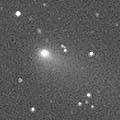
|
Although it was reported so faint as 16-20 mag at the discovery in September, it is actually much brighter, around 14 mag. It was also visible visually as 13.6 mag (Sept. 25, Werner Hasubick). Then it brightened furthermore, 12.6 mag on Nov. 4 (Juan Jose Gonzalez). It must have been observable as 14-15 mag in 2004 spring and summer, but it was not discovered at that time. Therefore, now it may be in an unusual temporary outburst. In late November, it seems to be a bit fainter. It became invisible visually, fainer than 13.5 mag, on Dec. 9 (Andrew Pearce).
Date(TT) R.A. (2000) Decl. Delta r Elong. m1 Best Time(A, h)
Dec. 24 1 35.08 23 37.1 2.385 2.973 117 14.5 21:02 (155, 27)
Dec. 31 1 37.97 23 20.4 2.498 3.000 111 14.6 21:03 (148, 25)
|

|
Recovery of a peculiar asteroid 2004 FS101 discovered in 2004 spring. Although it was 18 mag in mid January, it has been brightening rather faster than a typical comet, and it reached to 16 mag in early September. It keeps observable at 15-16 mag for a long time from 2005 spring to the end of 2006. Because it moves in the northern sky, it keeps observable for a long time in the Northern Hemisphere. It is brightest until May, but keeps lower than 30 deg high. It was not visible visually, fainter than 14.0 mag on Aug. 5 (Seiichi Yoshida), when the altitude was high.
Date(TT) R.A. (2000) Decl. Delta r Elong. m1 Best Time(A, h)
Dec. 24 17 50.17 51 36.3 3.369 3.259 75 14.7 2:56 (229,-51)
Dec. 31 18 13.67 52 9.1 3.351 3.247 75 14.6 3:02 (228,-50)
|

|
It was fantastic, so bright as 3.5 mag, so large as 30 arcmin, locating high overhead at its best time in early 2004 January. Then it had been getting fainter and smaller gradually, 12.5 mag on Sept. 3 (Edwin van Dijk) and 13.8 mag on Oct. 19 (Mitsunori Tsumura). It is appearing again in the morning sky, but not been observed yet. It will keep observable using CCD cameras until next summer.
Date(TT) R.A. (2000) Decl. Delta r Elong. m1 Best Time(A, h)
Dec. 24 16 22.68 0 14.7 5.161 4.393 35 15.0 2:56 (281,-16)
Dec. 31 16 28.47 0 3.2 5.176 4.462 39 15.1 3:02 (277,-10)
|
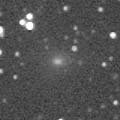
|
It reached to 11.4 mag in August (Aug. 12, Juan Jose Gonzalez). It was expected to start fading since early September. But actually, it keeps bright as 11.8 mag still on Oct. 7 (Juan Jose Gonzalez). Because it had been very low in the morning, it was not observed visually after that. It was bright as 13.8 mag still on Oct. 31 (Ken-ichi Kadota). However, it must be already faint around 15 mag.
Date(TT) R.A. (2000) Decl. Delta r Elong. m1 Best Time(A, h)
Dec. 24 13 32.17 -0 3.3 2.279 2.170 71 15.2 2:56 (256, 19)
Dec. 31 13 34.35 -1 34.4 2.257 2.250 77 15.3 3:02 (252, 26)
|
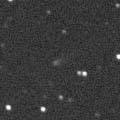
|
Although it was faint as 18 mag at the discovery in 2004 November, then it brightened very rapidly until early 2005, and reached to 16.0 mag on May 7 (Ken-ichi Kadota). After it appeared in the morning sky again, it continued brightening furthermore, and reached to 14.7 mag on Nov. 22 (Ken-ichi Kadota). It will be visible visually around 13.5 mag. After this, it keeps bright as 15 mag for a long time until 2006 spring. In the Northern Hemisphere, it keeps observable in good condition until 2006 summer when it becomes too faint.
Date(TT) R.A. (2000) Decl. Delta r Elong. m1 Best Time(A, h)
Dec. 24 13 23.46 12 40.8 2.538 2.536 78 15.3 2:56 (244, 13)
Dec. 31 13 32.44 12 20.5 2.477 2.555 83 15.4 3:02 (240, 17)
|

|
It brightened faster than a typical comet, and it reached to 16.4 mag on Dec. 2 (Katsumi Yoshimoto). It will be observable in good condition as 16 mag for a long time until next spring.
Date(TT) R.A. (2000) Decl. Delta r Elong. m1 Best Time(A, h)
Dec. 24 10 55.12 61 21.1 4.433 4.989 119 16.0 2:56 (193, -9)
Dec. 31 10 57.91 62 17.7 4.391 4.985 122 16.0 3:02 (189, -9)
|
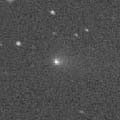
|
It was observed as 17.0 mag on July 10. Then it brightened as expected and reached to 15.0 mag on Oct. 1 (Mitsunori Tsumura). It was also visible visually as 13.5 mag Oct. 24 (Seiichi Yoshida). The second component was found at 18 mag on Nov. 30 about 20 arcmin from the main component. The main component also started fading, and it is 16 mag now.
Date(TT) R.A. (2000) Decl. Delta r Elong. m1 Best Time(A, h)
Dec. 24 0 39.52 -2 4.7 2.034 2.351 96 16.0 21:02 (124, 41)
Dec. 31 0 47.61 -1 0.1 2.115 2.351 91 16.1 21:03 (120, 37)
|
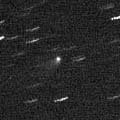
|
It was visible visually as 14.3 mag in 2005 spring (July 10, Edwin van Dijk). Although it has been not observable for a while, now it is appearing in the morning sky again. Now it is 16.7 mag (Dec. 18, Ken-ichi Kadota). Ken-ichi Kadota reported that a faint anti-tail is visible. It will be observable in good condition again in 2006 spring, but only 16 mag at best. Then it will fade out rapidly, and become fainter than 18 mag in July.
Date(TT) R.A. (2000) Decl. Delta r Elong. m1 Best Time(A, h)
Dec. 24 13 58.43 6 36.2 4.004 3.752 68 16.3 2:56 (255, 10)
Dec. 31 13 56.27 7 2.7 3.901 3.779 75 16.2 3:02 (249, 16)
|

|
The component C was recovered on Oct. 22 as 19.3 mag (C. W. Hergenrother). Then it brightened to 17.0 mag on Dec. 17 (Ken-ichi Kadota). It will pass only 0.08 AU from the earth on May 12, remarkable approach after 76 years since its discovery in 1930. It was expected be so bright as 2 mag, but actually, it was fainter than its last appearance by 1.5 mag. Anyway, it will be 3.5 mag at best, and will be visible with naked eyes. It keeps observable in good condition all through the encounter in May. Brightening rapidly, and will be visible visually as 14 mag in late January. The components B (F) and E have not been recovered yet. The component B (F) will reach to 7 mag in May. However, it may be fainter than its last appearance as the component C. The component E may have already disappeared because it faded before the perihelion passage in its last appearance in 2001. Due to the approach of the comet, Bootids meteor shower observed in 1930 may appear in outburst again in 2005 May and June.
Date(TT) R.A. (2000) Decl. Delta r Elong. m1 Best Time(A, h)
Dec. 24 12 24.07 11 21.0 1.979 2.228 91 16.7 2:56 (235, 24)
Dec. 31 12 34.23 10 58.4 1.836 2.167 95 16.4 3:02 (230, 28)
|
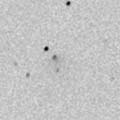
|
It passes the perihelion in 2006 February. But it is outside of Jupiter's orbit. So it keeps 17 mag for a long time. Because it moves in the northern sky, it keeps locating high and observable in good condition until 2006 summer.
Date(TT) R.A. (2000) Decl. Delta r Elong. m1 Best Time(A, h)
Dec. 24 15 14.67 64 31.4 6.659 6.803 94 16.7 2:56 (210,-32)
Dec. 31 15 20.12 64 41.4 6.629 6.801 95 16.7 3:02 (209,-29)
|
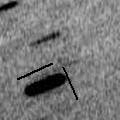
|
It was observed around 20 mag in early October, as bright as expected. It brightened up to 17.9 mag on Nov. 30 (Yuji Ohshima). It will be observable in good condition at around 17 mag from December to March.
Date(TT) R.A. (2000) Decl. Delta r Elong. m1 Best Time(A, h)
Dec. 24 10 51.54 2 58.6 1.181 1.766 109 17.0 2:56 (218, 45)
Dec. 31 10 59.38 1 18.0 1.126 1.768 113 16.9 3:02 (211, 49)
|

|
It reached to 17 mag in 2004 autumn. It will be observable as 17 mag in good condition in this winter again. It was reported as 18 mag recently, fainter than this ephemeris by about 1 mag.
Date(TT) R.A. (2000) Decl. Delta r Elong. m1 Best Time(A, h)
Dec. 24 7 45.66 16 2.8 2.317 3.242 156 17.0 1:36 (180, 39)
Dec. 31 7 41.06 16 3.5 2.297 3.254 164 17.0 1:04 (180, 39)
|

|
Although it was so faint as 18.5 mag at the discovery in September, it brightened rapidly. It reached to 16.4 mag on Nov. 27 (Yuji Ohshima). It will be observable around 17 mag until March.
Date(TT) R.A. (2000) Decl. Delta r Elong. m1 Best Time(A, h)
Dec. 24 3 50.56 19 30.3 4.362 5.218 147 17.0 21:37 (180, 35)
Dec. 31 3 41.20 19 17.4 4.439 5.213 138 17.1 21:03 (179, 36)
|

|
It was not detected on Dec. 18, fainter than 18 mag (Masayuki Suzuki). It has not been observed in this return yet. But it is getting brighter rapidly in the morning sky. It will become visible visually at 13 mag in March, and will reach to 11 mag in June. The condition is best beucase it is almost at opposition at the perihelion passage. However, it will be very low, only 13-20 deg high, from June to September in the Northern Hemisphere. When it gets higher again, it will be fainter than 14 mag, too faint to see visually.
Date(TT) R.A. (2000) Decl. Delta r Elong. m1 Best Time(A, h)
Dec. 24 14 7.50 -5 58.4 2.470 2.164 60 17.3 2:56 (266, 16)
Dec. 31 14 20.96 -7 11.9 2.362 2.126 64 17.1 3:02 (265, 20)
|

|
It passed the perihelion on Apr. 10 and reached to 8 mag in the southern sky. The nucleus was split into two components and it had a broad long dust tail. Then it had been fading slowly, and it was visible visually still on Oct. 25 as 13.5 mag (Seiichi Yoshida). However, it is fading rapidly now. The component B has been already fainter than 18 mag. The component A is already faint as 16 mag.
Date(TT) R.A. (2000) Decl. Delta r Elong. m1 Best Time(A, h)
Dec. 24 22 25.51 23 42.8 3.838 3.758 77 17.2 21:02 (119, 0)
Dec. 31 22 29.46 23 53.9 4.009 3.835 72 17.4 21:03 (116, -5)
|

|
It reached to 13 mag and was observed visually in good condition in 2004 autumn. It has been not observable since August, but it is appearing at dawn again. It keeps 17 mag until late April. But it will go away soon after that. Next return is in 2018, when it will be 14.3 mag at best.
Date(TT) R.A. (2000) Decl. Delta r Elong. m1 Best Time(A, h)
Dec. 24 13 32.44 7 43.3 3.711 3.575 74 17.3 2:56 (250, 14)
Dec. 31 13 35.58 7 15.8 3.651 3.618 80 17.3 3:02 (245, 20)
|
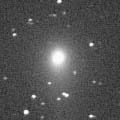
|
It was 17.3 mag on Nov. 1 (Ken-ichi Kadota), fading slowly as expected. It will be fainter than 18 mag in March. It keeps locating high.
Date(TT) R.A. (2000) Decl. Delta r Elong. m1 Best Time(A, h)
Dec. 24 13 29.31 35 7.0 4.510 4.590 88 17.3 2:56 (228, -3)
Dec. 31 13 31.24 35 26.5 4.481 4.648 93 17.4 3:02 (224, 1)
|
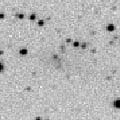
|
It was 13.6 mag on May 12, as bright as expected (Michael Mattiazzo). After that, no successful observations were reported for a while even when the comet became locating high also in the Northern Hemisphere. Actually, it was 17.1 mag on Sept. 3 (Ken-ichi Kadota). It seems the comet faded faster than expected. But it will keep 17 mag for a while.
Date(TT) R.A. (2000) Decl. Delta r Elong. m1 Best Time(A, h)
Dec. 24 4 25.52 9 35.7 2.106 3.007 151 17.4 22:12 (180, 45)
Dec. 31 4 20.65 9 58.5 2.193 3.045 144 17.6 21:40 (180, 45)
|
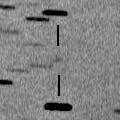
|
It was recovered at 17.3 mag on Sept. 7 (Filip Fratev), as bright as exepcted. It will be fainter than 18 mag in February.
Date(TT) R.A. (2000) Decl. Delta r Elong. m1 Best Time(A, h)
Dec. 24 11 53.13 20 38.2 1.561 2.006 101 17.5 2:56 (222, 22)
Dec. 31 12 1.89 21 44.3 1.522 2.037 106 17.5 3:02 (216, 24)
|
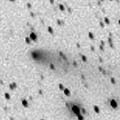
|
It was 16.8 mag at the discovery in May (May 20, R. H. McNaught). Then it brightened rapidly, and became visible visually as 13.7 mag (Sept. 3, Edwin van Dijk). Because it moves in the northern sky, it keeps locating high for a long time in the Northern Hemisphere. However, it is fading rapidly now. It faded down to 16.2 mag on Nov. 27 (Mitsunori Tsumura). It will be fainter than 18 mag in early January.
Date(TT) R.A. (2000) Decl. Delta r Elong. m1 Best Time(A, h)
Dec. 24 4 1.15 49 36.4 1.164 2.042 143 17.5 21:48 (180, 5)
Dec. 31 3 59.75 48 19.0 1.238 2.086 139 17.8 21:20 (180, 7)
|
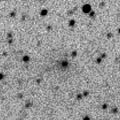
|
It was observed as 17.7 mag in November at opposition (Nov. 3, Ken-ichi Kadota). It will be fainter than 18 mag in February. However, it will be observable at 18 mag again one year later, in next spring.
Date(TT) R.A. (2000) Decl. Delta r Elong. m1 Best Time(A, h)
Dec. 24 3 28.81 17 23.8 3.748 4.563 141 17.6 21:16 (180, 38)
Dec. 31 3 25.96 17 23.2 3.831 4.571 134 17.6 21:03 (175, 37)
|
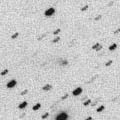
|
It was expected to reach to 13 mag in 2005 spring at the perihelion passage. However, the brightness evolution was very slow actually and it was only 14.5 mag at best. Now it is getting higher again in the morning. The fading is very slow, too. The current distance is almost same as that at the discovery, and the brightness faded to 17.9 mag, as bright as at the discovery (Nov. 3, Ken-ichi Kadota).
Date(TT) R.A. (2000) Decl. Delta r Elong. m1 Best Time(A, h)
Dec. 24 6 38.86 7 53.4 2.697 3.649 162 17.7 0:30 (180, 47)
Dec. 31 6 23.17 8 35.0 2.750 3.708 164 17.7 23:41 (180, 46)
|

|
It will reach to 15.5 mag from late 2006 to early 2007 although locating rather low. It is observable around 17 mag from this winter to spring.
Date(TT) R.A. (2000) Decl. Delta r Elong. m1 Best Time(A, h)
Dec. 24 10 34.38 -6 59.9 4.975 5.370 108 17.8 2:56 (221, 55)
Dec. 31 10 29.39 -7 29.0 4.823 5.332 116 17.7 3:02 (206, 60)
|

|
New faint comet. It will be only 18 mag at best in December and January. However, Yuji Ohshima reported it was bright as 16.5 mag on Nov. 27, much brighter than this ephemeris.
Date(TT) R.A. (2000) Decl. Delta r Elong. m1 Best Time(A, h)
Dec. 24 3 31.53 34 33.3 2.581 3.426 143 17.7 21:19 (180, 20)
Dec. 31 3 30.43 34 9.4 2.624 3.412 137 17.7 21:03 (177, 21)
|

|
First return of a new periodic comet discovered in 1998. The condition is very good and it became brighter in this appearance than at the discovery. It was recovered in July at 19.5 mag, then it brightened as expected, and reached to 16 mag in September. Now it is fading rapidly, and it will be fainter than 18 mag at the end of 2005.
Date(TT) R.A. (2000) Decl. Delta r Elong. m1 Best Time(A, h)
Dec. 24 23 32.06 20 49.5 1.179 1.536 90 17.7 21:02 (128, 13)
Dec. 31 23 49.79 23 17.1 1.249 1.566 88 17.9 21:03 (128, 10)
|

|
New comet. Although it was announced so faint as 19 mag, it is actually much brighter, 17.1 mag on Nov. 27 (Yuji Ohshima). However, it will be fainer than 18 mag in January.
Date(TT) R.A. (2000) Decl. Delta r Elong. m1 Best Time(A, h)
Dec. 24 1 58.14 15 20.0 2.215 2.844 120 17.8 21:02 (157, 37)
Dec. 31 2 0.85 15 21.3 2.296 2.843 114 17.8 21:03 (150, 34)
|
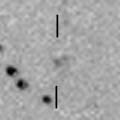
|
It was 16.8 mag on Sept. 9 (Yuji Ohshima). It keeps good condition for a long time. But it will fade out after this, and will be fainter than 18 mag in early January.
Date(TT) R.A. (2000) Decl. Delta r Elong. m1 Best Time(A, h)
Dec. 24 1 14.52 19 14.0 1.603 2.171 111 17.9 21:02 (148, 29)
Dec. 31 1 24.48 18 49.3 1.694 2.194 107 18.1 21:03 (143, 27)
|

|
It will be observable at 18 mag in good condition until May.
Date(TT) R.A. (2000) Decl. Delta r Elong. m1 Best Time(A, h)
Dec. 24 15 20.72 52 29.9 4.986 4.987 84 18.0 2:56 (224,-29)
Dec. 31 15 22.23 53 41.8 4.920 4.981 87 17.9 3:02 (221,-25)
|
|
![]()
 C/2005 R4 ( LINEAR )
C/2005 R4 ( LINEAR ) 71P/Clark
71P/Clark C/2005 A1 ( LINEAR )
C/2005 A1 ( LINEAR ) (944) Hidalgo
(944) Hidalgo C/2004 Q1 ( Tucker )
C/2004 Q1 ( Tucker ) 10P/Tempel 2
10P/Tempel 2 171P/2005 R3 ( Spahr )
171P/2005 R3 ( Spahr ) P/2005 K3 ( McNaught )
P/2005 K3 ( McNaught ) 65P/Gunn
65P/Gunn C/2004 L1 ( LINEAR )
C/2004 L1 ( LINEAR ) C/2005 EL173 ( LONEOS )
C/2005 EL173 ( LONEOS ) C/2005 W2 ( Christensen )
C/2005 W2 ( Christensen ) 168P/2005 N2 ( Hergenrother )
168P/2005 N2 ( Hergenrother ) P/2005 S3 ( Read )
P/2005 S3 ( Read ) P/2005 R1 ( NEAT )
P/2005 R1 ( NEAT ) C/2005 G1 ( LINEAR )
C/2005 G1 ( LINEAR )![]()

























